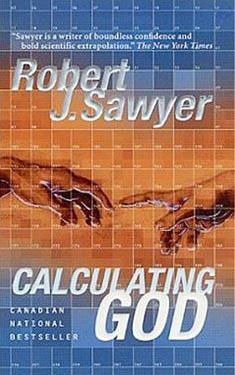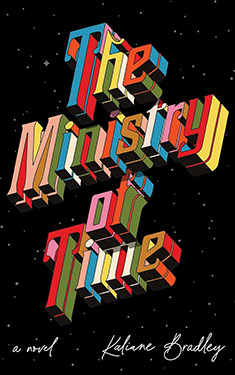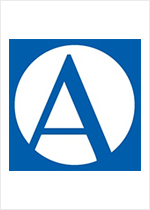
Added By: Administrator
Last Updated: Administrator
Calculating God
| Author: | Robert J. Sawyer |
| Publisher: |
Tor, 2000 |
| Series: | |
|
This book does not appear to be part of a series. If this is incorrect, and you know the name of the series to which it belongs, please let us know. |
|
| Book Type: | Novel |
| Genre: | Science-Fiction |
| Sub-Genre Tags: | First Contact Theological Near-Future |
| Awards: | |
| Lists: | |
| Links: |
|
| Avg Member Rating: |
|
|
|
|
Synopsis
Calculating God is the new near-future SF thriller from the popular and award-winning Robert J. Sawyer. An alien shuttle craft lands outside the Royal Ontario Museum in Toronto. A six-legged, two-armed alien emerges, who says, in perfect English, "Take me to a paleontologist."
It seems that Earth, and the alien's home planet, and the home planet of another alien species traveling on the alien mother ship, all experienced the same five cataclysmic events at about the same time (one example of these "cataclysmic events" would be the meteor that wiped out the dinosaurs). Both alien races believe this proves the existence of God: i.e. he's obviously been playing with the evolution of life on each of these planets.
From this provocative launch point, Sawyer tells a fast-paced, and morally and intellectually challenging, SF story that just grows larger and larger in scope. The evidence of God's universal existence is not universally well received on Earth, nor even immediately believed. And it reveals nothing of God's nature. In fact. it poses more questions than it answers.
When a supernova explodes out in the galaxy but close enough to wipe out life on all three home-worlds, the big question is, Will God intervene or is this the sixth cataclysm?
Calculating God is SF on the grand scale.
Excerpt
Chapter 1
I know, I know - it seemed crazy that the alien had come to Toronto. Sure, the city is popular with tourists, but you'd think a being from another world would head for the United Nations - or maybe to Washington. Didn't Klaatu go to Washington in Robert Wise's movie The Day the Earth Stood Still?
Of course, one might also think it's crazy that the same director who did West Side Story would have made a good science-fiction flick. Actually, now that I think about it, Wise directed three SF films, each more stolid than its predecessor.
But I digress. I do that a lot lately - you'll have to forgive me. And, no, I'm not going senile; I'm only fifty-four, for God's sake. But the pain sometimes makes it hard to concentrate.
I was talking about the alien.
And why he came to Toronto.
It happened like this...
* * *
The alien's shuttle landed out front of what used to be the McLaughlin Planetarium, which is right next door to the Royal Ontario Museum, where I work. I say it used to be the planetarium because Mike Harris, Ontario's tight-fisted premier, cut the funding to the planetarium. He figured Canadian kids didn't have to know about space - a real forward-thinking type, Harris. After he closed the planetarium, the building was rented out for a commercial Star Trek exhibit, with a mockup of the classic bridge set inside what had been the star theater. As much as I like Star Trek, I can't think of a sadder comment on Canadian educational priorities. A variety of other private-sector concerns had subsequently rented the space, but it was currently empty.
Actually, although it was perhaps reasonable for an alien to visit a planetarium, it turned out he really wanted to go to the museum. A good thing, too: imagine how silly Canada would have looked if first contact were made on our soil, but when the extraterrestrial ambassador knocked on the door, no one was home. The planetarium, with its white dome like a giant igloo, is set well back from the street, so there's a big concrete area in front of it - perfect, apparently, for landing a small shuttle.
Now, I didn't see the landing firsthand, even though I was right next door. But four people - three tourists and a local - did get it on video, and you could catch it endlessly on TV around the world for days afterward. The ship was a narrow wedge, like the slice of cake someone takes when they're pretending to be on a diet. It was solid black, had no visible exhaust, and had dropped silently from the sky.
The vessel was maybe thirty feet long. (Yeah, I know, I know - Canada's a metric country, but I was born in 1946. I don't think anyone of my generation - even a scientist, like me - ever became comfortable with the metric system; I'll try to do better, though.) Rather than being covered with robot puke, like just about every spaceship in every movie since Star Wars, the landing craft's hull was completely smooth. No sooner had the ship set down than a door opened in its side. The door was rectangular, but wider than it was tall. And it opened by sliding up - an immediate clue that the occupant probably wasn't human; humans rarely make doors like that because of our vulnerable heads.
Seconds later, out came the alien. It looked like a giant, golden-brown spider, with a spherical body about the size of a large beach ball and legs that splayed out in all directions.
A blue Ford Taurus rear-ended a maroon Mercedes-Benz out front of the planetarium as their drivers gawked at the spectacle. Many people were walking by, but they seemed more dumbfounded than terrified - although a few did run down the stairs into Museum subway station, which has two exits in front of the planetarium.
The giant spider walked the short distance to the museum; the planetarium had been a division of the ROM, and so the two buildings are joined by an elevated walkway between their second floors, but an alley separates them at street level. The museum was erected in 1914, long before anyone thought about accessibility issues. There were nine wide steps leading up to the six main glass doors; a wheelchair ramp had been added only much later. The alien stopped for a moment, apparently trying to decide which method to use. It settled on the stairs; the railings on the ramp were a bit close together, given the way its legs stuck out.
At the top of the stairs, the alien was again briefly flummoxed. It probably lived in a typical sci-fi world, full of doors that slid aside automatically. It was now facing the row of exterior glass doors; they pull open, using tubular handles, but he didn't seem to comprehend that. But within seconds of his arrival, a kid came out, oblivious to what was going on at first, but letting out a startled yelp when he saw the extraterrestrial. The alien calmly caught the open door with one of its limbs - it used six of them for walking, and two adjacent ones as arms - and managed to squeeze through into the vestibule. A second wall of glass doors faced him a short distance ahead; this air-lock-like gap helped the museum control its interior temperature. Now savvy in the ways of terrestrial doors, the alien pulled one of the inner ones open and then scuttled into the Rotunda, the museum's large, octagonal lobby; it was such a symbol of the ROM that our quarterly members magazine was called Rotunda in its honor.
On the left side of the Rotunda was the Garfield Weston Exhibition Hall, used for special displays; it currently housed the Burgess Shale show I'd helped put together. The world's two best collections of Burgess Shale fossils were here at the ROM and at the Smithsonian; neither institution normally had them out for the public to see, though. I'd arranged for a temporary pooling of both collections to be exhibited first here, then in Washington.
The wing of the museum to the right of the Rotunda used to contain our late, lamented Geology Gallery, but it now held gift shops and a Druxy's deli - one of many sacrifices the ROM had made under Christine Dorati's administration to becoming an "attraction."
Anyway, the creature moved quickly to the far side of the Rotunda, in between the admissions desk and the membership-services counter. Now, I didn't see this part firsthand, either, but the whole thing was recorded by a security camera, which is good because no one would have believed it otherwise. The alien sidled up to the blue-blazered security officer - Raghubir, a grizzled but genial Sikh who'd been with the ROM forever - and said, in perfect English, "Excuse me. I would like to see a paleontologist."
Raghubir's brown eyes went wide, but he quickly relaxed. He later said he figured it was a joke. Lots of movies are made in Toronto, and, for some reason, an enormous number of science-fiction TV series, including over the years such fare as Gene Roddenberry's Earth: Final Conflict, Ray Bradbury Theater, and the revived Twilight Zone. He assumed this was some guy in costume or an animatronic prop. "What kind of paleontologist?" he said, deadpan, going along with the bit.
The alien's spherical torso bobbed once. "A pleasant one, I suppose."
On the video, you can see old Raghubir trying without complete success to suppress a grin. "I mean, do you want an invertebrate or a vertebrate?"
"Are not all your paleontologists humans?" asked the alien. He had a strange way of talking, but I'll get to that. "Would they not therefore all be vertebrates?"
I swear to God, this is all on tape.
"Of course, they're all human," said Raghubir. A small crowd of visitors had gathered, and although the camera didn't show it, apparently a number of people were looking down onto the Rotunda's polished marble floor from the indoor balconies one level up. "But some specialize in vertebrate fossils and some in invertebrates."
"Oh," said the alien. "An artificial distinction, it seems to me. Either will do."
Raghubir lifted a telephone handset and dialed my extension. Over in the Curatorial Centre, hidden behind the appalling new Inco Limited Gallery of Earth Sciences - the quintessential expression of Christine's vision for the ROM - I picked up my phone. "Jericho," I said.
"Dr. Jericho," said Raghubir's voice, with its distinctive accent, "there's somebody here to see you."
Now, getting to see a paleontologist isn't like getting to see the CEO of a Fortune 500; sure, we'd rather you made an appointment, but we are civil servants - we work for the taxpayers. Still: "Who is it?"
Raghubir paused. "I think you'll want to come and see for yourself, Dr. Jericho."
Well, the Trodon skull that Phil Currie had sent over from the Tyrrell had waited patiently for seventy million years; it could wait a little longer. "I'll be right there." I left my office and made my way down the elevator, past the Inco Gallery - God, how I hate that thing, with its insulting cartoon murals, giant fake volcano, and trembling floors - through the Currelly Gallery, out into the Rotunda, and -
And-
Jesus.
Jesus Christ.
I stopped dead in my tracks.
Raghubir might not know the difference between real flesh and blood and a rubber suit, but I do. The thing now standing patiently next to the admissions desk was, without doubt, an authentic biological entity. There was no question in my mind whatsoever. It was a lifeform -
And -
And I had studied life on Earth since its beginnings, deep in the Precambrian. I'd often seen fossils that represented new species or new genera...
Copyright © 2000 by Robert J. Sawyer
Reviews
Images
No alternate cover images currently exist for this novel.



















 Full Details
Full Details





